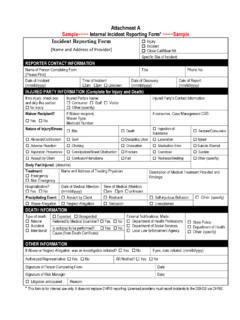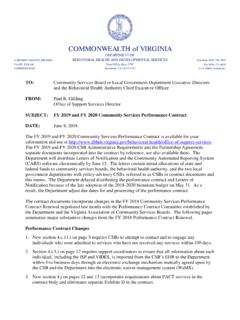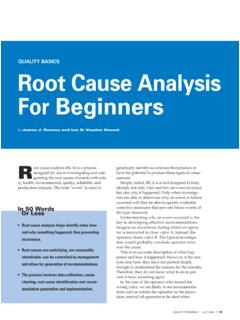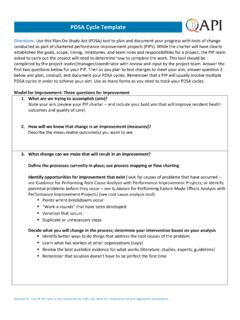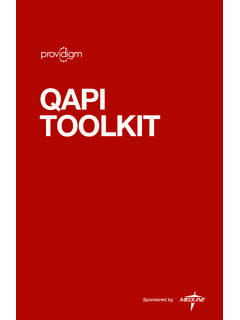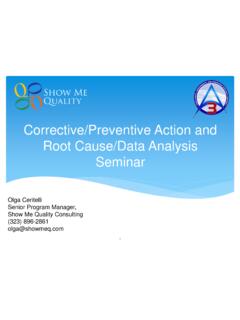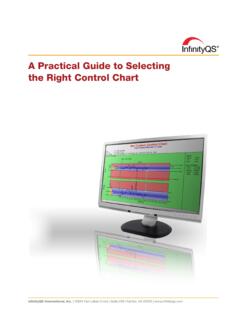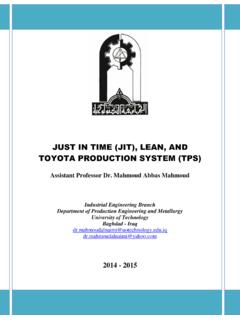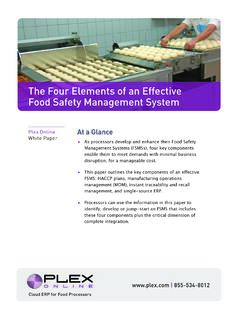Transcription of Root Cause Analysis Training - Virginia Department of ...
1 1 The goals of this presentation are limited. root Cause Analysis has long been used by health care organizationsafter adverse events and/or to determine how to improve processes. Internet searches provide numerous resources for information on focus of this Training is to assist with meeting the components of conducting an RCA pursuant to the DBHDS licensing this presentation also includes some additional material which may be considered best practice for an RCA, these are not required by the regulations. The presentation also highlights a couple approaches to conducting an RCA but additional approaches are available from other resources. Some additional resources are listed at the conclusion of this RCA is considered to be a standard quality improvement tool (per regulation).
2 So you are using this tool to improve processes and systems in order to mitigate or reduce the risk of purpose of an RCA is to identify system vulnerabilities so that they can be eliminated or mitigated. While licensing regulations require RCAs, licensed providers should consider the process as a best practice for improving outcomes. A root Cause Analysis is a tool for a provider to use when determining where they might focus their quality improvement efforts in terms of developing quality improvement initiatives. For example, a provider wants to reducemedication errors so the RCA could be utilized to get at the root Cause (or causes ) which you want to address through a quality improvement initiative. Thereare other tools for identifying quality improvement opportunities such as a Failure, Mode and Effects RCA focuses on system, processes, and outcomes.
3 It does not focus on people. While the process involves analyzing who did what, it is for purposes of looking for systems and process problems, not personnel , a root Cause Analysis is about taking root Cause Analysis begins with the assumption that no one comes to work intending to make a mistake or to hurt noted in the best selling book of 1999,To Err isHuman;Building A Safer Health System, people make mistakes but awareness of medical errors is important in terms of improving systems. To develop a culture of safety, staff should be encouraged to report errors without fear of retribution and to look for ways to improve s not to say that aroot Cause Analysis never uncovers intentional acts of harm. That may happen and when it does, you must take the appropriate noted earlier, a RCA shouldnot be limited to just Level II or Level III serious incidents but this is what the regulations require.
4 Providers are encouraged to think about always improving processes and outcomes and that involves looking for root causes to the incident reporting guidance, "during the provision of service" means when the provider is actively providing a service to the establish the minimumrequirements. Each provider s policy will further determine when more is by making sure all three minimum requirements are detailed description of what happened A provider can start with the incident report which provides date, time, place, individuals involved, a description of what could include what immediate actions were taken. This initial sequence of events helps identify what occurred. Often it is a chain of events that resulted in an more than one staff member was involved, each staff member could write what happened from their is possible that others may have seen something even if they were not directly involved in the incident ( they saw something from the window).
5 7 This second minimum requirement is where the work Compare what happened to what should have happened before, during and after the Compare actions taken before, during and after the incident to the requirements in the provider s policies and procedures, DBHDS licensing and other applicable regulations, accreditation standards and applicable Clearly identify the underlying causes of the incident that were under the control of the why here is important. Based on the incident you could complete a 5 Whys purpose of an RCA is to prevent reoccurrence. The question is what should we do to prevent this in the future? not What should we have done to prevent this from having occurred? Mitigating futurerisk is the most important question providers can ask as a part of their incident reporting, risk management, and quality improvement RCA should identify solutions, as applicable, to be taken by the provider to keep the situation from occurring again or minimize the likelihoodof its reoccurrence and future risk of harm when applicable.
6 Then the identified solutions to mitigate its reoccurrence should be solutions should be both individual-specific and systemic as indicated by the Analysis of the incident. Implementation of solutions and their efficacy could be monitored as part of the provider s quality improvement is really best should view root Cause Analysis as an opportunity to address systems issues on an ongoing basis. The regulations, however, allow for someflexibilityfor when a provider completes a more detailed has made changes to provide greater clarity relating to when a provider should conduct a more detailed root Cause incident management and root Cause Analysis components of this regulatory action are at the heart of the Department s efforts to fully comply with the Settlement Agreement s quality and risk management provisions.
7 In the time since the emergency regulation became effective, the Department has issued additional guidance related to what constitutes during the provision of services. A provider's RCA policy should be specific to the organization. Consider size, population served; make it service specific, outline thecriteria to use when determining the need for the more detailed RCA. The policy could outline who will appoint a team if a more detailed RCA is being conducted. The only requirement is that the policy include the minimum requirements outlined in the regulations set some provider will need to determine (by its policy) theminimum the following example provides a starting the data related to falls with injury for our example of XYZ on their policy (previous slide) would a more detailed RCA be required?
8 Some might quickly say no -because actually their falls with serious injury declined (in September and October there were none). The provider s policy, however, required a more detailed RCA when 5 similar Level II serious incidents occur within a six month time period across all three , theyshouldn t be waiting for 6 month time period, the provider met the threshold outlined in their policy in July. Therewere two falls in June and four falls in July so they had six falls in two months (across all locations).17A more detailed RCA is outlined in the regulationsas including -convening a team, collecting and analyzing data, mapping processes, and charting causal processes flow chart, storyboards, process maps, factors causal factor can be defined as any major unplanned, unintended contributorto an incident (a negative event or undesirable condition), that if eliminated would have either prevented the occurrence of the incident or reduced its severity or frequency.
9 18In the example provided, XYZ Residential would begin by convening a team. It doesn t have to be a large team. In most cases, a RCA team may consist of 4-5 people and would be interdisciplinary. Different professional backgrounds can support creative thinking. The team members should be given a quick overview of what a RCA is and what it is not. Review rules of behavior ( not about blame). Avoid hindsight bias (Monday morning quarterback). Teams can jump to conclusions so need to follow outline of how to effectively conduct a licensing regulations also require that providers designate a person responsible for the risk management function who has Training and expertise in conducting investigations, root Cause Analysis , and data Analysis .
10 Depending on the incident and the organization, this person (the designated risk manager) may serve as the lead on the RCA team or provide guidance and an overview of the team s you include employees who were involved in the incident if conducting an RCA related to an adverse event?In order to understand what happened and why it happened, it is necessary to talk openly during the team meetings about the actions of those individuals immediately involved in the event. Therefore the RCA literature states that the disadvantages of including involved staff outweigh the benefits. Reasons included:-If they were involved, other team members may refrain from speaking up or be 19hesitant to say something that might offend those , those involved in the event may actually be overly harsh when judging their own actions-It is less likely that those involved may steer the team from looking deeply into area that they feel will not reflect well on them involved staff can and should be interviewed.

